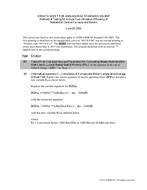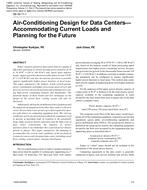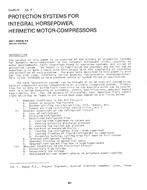The Thermosyphon Cooler Hybrid System (TCHS) integrates the control of a dry heat rejection device, the thermosyphon cooler (TSC), with an open cooling tower. A combination of equipment and controls, this new heat rejection system embraces the “smart use of water,” using evaporative cooling when it is most advantageous and then saving water and modulating toward increased dry sensible cooling as system operations and ambient weather conditions permit. Innovative fan control strategies ensure the most economical balance between water savings and parasitic fan energy. The unique low-pressure-drop design of the TSC allows water to be cooled directly by the TSC evaporator without risk of bursting tubes in subfreezing ambient conditions.
Johnson Controls partnered with two national laboratories–the National Renewable Energy Laboratory (NREL) in Golden, Colorado, and Sandia National Laboratories in Albuquerque, New Mexico–to deploy the TSC as a test bed at NREL’s high-performance computing (HPC) data center in the first half of 2016. Located in the Energy Systems Integration Facility (ESIF), this HPC data center has achieved an annualized average power usage effectiveness rating of 1.06 or better since 2012. Warm-water liquid cooling is used to capture heat generated by computer systems direct to water; that waste heat is either reused as the primary heat source in the ESIF building or rejected using evaporative cooling. This data center is the single largest source of water and power demand on the campus, using about 7,600 m³ (2.0 million gal) of water during the past year with an hourly average Internet technology load of nearly 1 MW (3.4 million Btu/h)–so dramatically reducing water use while continuing efficient data center operations is of significant interest. This new heat rejection system being deployed at the ESIF has gained interest because the climate at the laboratory in New Mexico is similar to that of the laboratory in Colorado, and the laboratory data centers in New Mexico utilize an hourly average of 8.5 MW (29 million Btu/h) and are also one of the largest consumers of water on-site.
In addition to describing the installation of the TSC and its integration into the ESIF, this paper focuses on the full heat rejection system simulation program used for hourly analysis of the energy and water consumption of the complete system under varying operating scenarios. A follow-up paper will detail the test results. The evaluation of the TSC’s performance at the laboratory in Colorado will also determine a path forward at the laboratory in New Mexico for possible deployment in a large-scale system not only for data center use but also possibly site wide.
Citation: 2017 Winter Conference, Las Vegas, NV, Conference Papers
Product Details
- Published:
- 2017
- Number of Pages:
- 8
- Units of Measure:
- Dual
- File Size:
- 1 file , 2.6 MB
- Product Code(s):
- D-LV-17-C005


